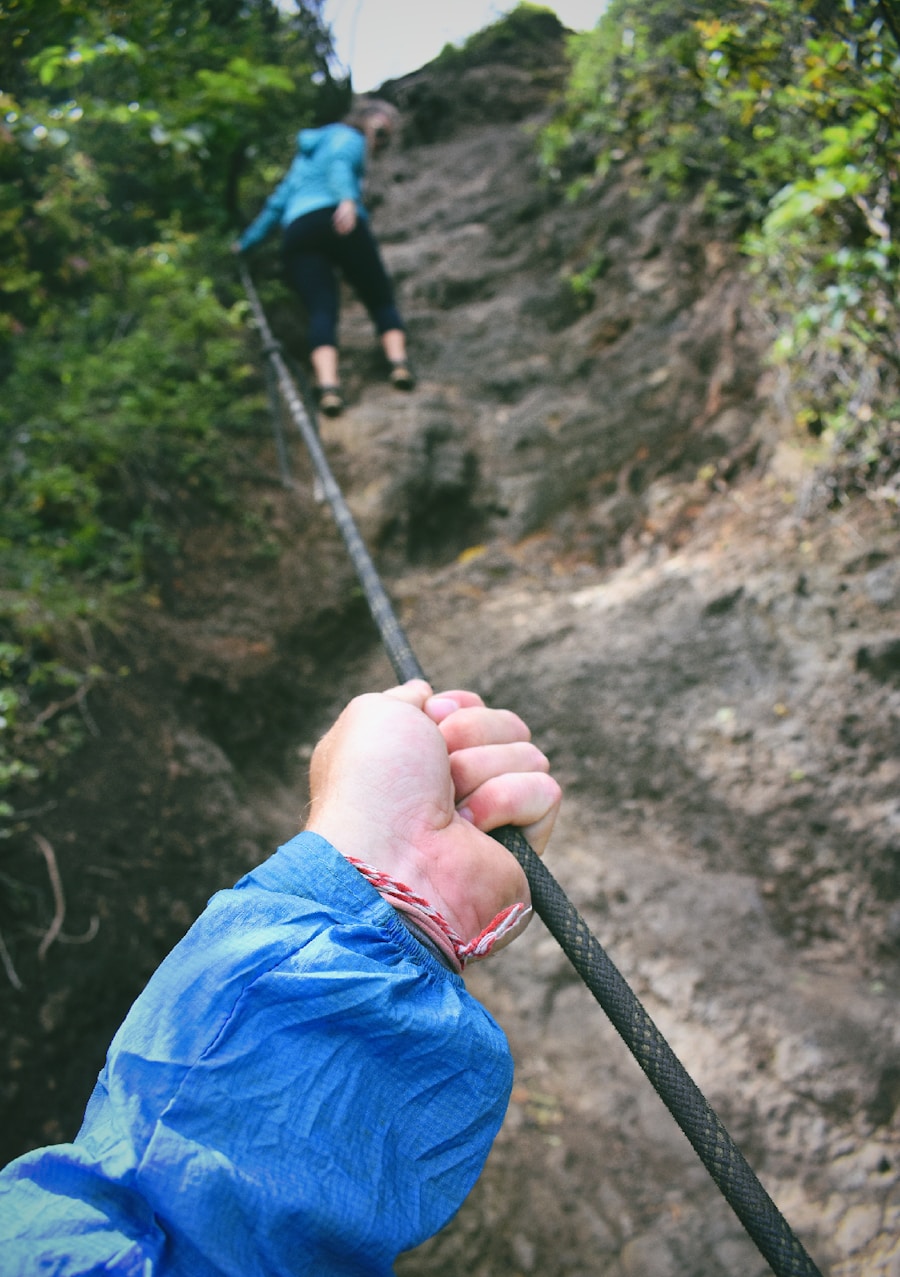Hiking poles, often overlooked by novice trekkers, can significantly enhance the hiking experience for both beginners and seasoned adventurers. One of the primary benefits of using hiking poles is the reduction of strain on the joints, particularly the knees. When traversing uneven terrain or descending steep slopes, the impact on the knees can be substantial.
By employing hiking poles, hikers can distribute their weight more evenly, effectively reducing the load on their lower limbs. This redistribution not only alleviates pressure on the knees but also helps to minimize fatigue over long distances, allowing hikers to maintain their stamina throughout the journey. In addition to joint protection, hiking poles provide stability and balance, which is especially beneficial when navigating rocky paths or slippery surfaces.
The extra points of contact with the ground can help prevent falls and slips, giving hikers greater confidence in their footing. This is particularly important in challenging environments such as mountainous regions or during inclement weather. Furthermore, hiking poles can assist in maintaining an upright posture, which can lead to improved overall body alignment and reduced back strain.
The psychological boost of feeling secure while hiking cannot be understated; it allows hikers to focus more on the beauty of their surroundings rather than worrying about potential hazards.
Key Takeaways
- Hiking poles provide stability, reduce impact on joints, and improve balance and posture
- Consider factors such as material, weight, grip, and locking mechanism when choosing hiking poles
- Use a natural arm swing and plant the poles slightly ahead of you to maximize the benefits of hiking poles
- Regularly check and adjust the length and tightness of your hiking poles to ensure proper function
- Accessories like rubber tips, baskets, and camera mounts can enhance the functionality of your hiking poles
Choosing the Right Hiking Poles for You
Selecting the appropriate hiking poles involves considering several factors that cater to individual needs and preferences. One of the first aspects to evaluate is the material of the poles. Hiking poles are typically made from aluminum or carbon fiber.
Aluminum poles are known for their durability and resistance to bending, making them ideal for rugged terrains. Conversely, carbon fiber poles are lighter and absorb shock better, which can be advantageous for long-distance hikes where weight becomes a critical factor. Understanding your hiking style and the environments you frequent will guide you in making an informed choice between these materials.
Another crucial consideration is the pole’s adjustability. Many hiking poles come with adjustable lengths, allowing users to customize the height according to their stature and the terrain they are traversing. A general rule of thumb is that when standing upright with the pole, your elbow should form a 90-degree angle.
Fixed-length poles may be suitable for those who hike in similar conditions regularly but can limit versatility. Additionally, features such as locking mechanisms—whether twist-lock or lever-lock—should be assessed for ease of use and reliability. Comfort is also paramount; grips made from cork or foam can provide better moisture absorption and reduce hand fatigue during extended hikes.
Proper Technique for Using Hiking Poles

Mastering the proper technique for using hiking poles can significantly enhance their effectiveness and your overall hiking experience. When using hiking poles, it is essential to maintain a natural arm swing that mimics your walking motion. As you step forward with one leg, the opposite pole should move forward simultaneously.
This coordinated movement not only aids in balance but also helps propel you forward, effectively increasing your speed and efficiency on the trail. It is important to avoid overreaching with the poles; they should touch the ground just ahead of your feet rather than being thrust too far forward. When ascending or descending hills, adjusting your technique is crucial for maximizing the benefits of your poles.
During ascents, plant your poles firmly into the ground to provide leverage as you push upward with your legs. This technique allows you to engage your upper body muscles, distributing effort more evenly across your body. Conversely, when descending, it is advisable to use your poles to create a braking effect.
By placing them in front of you and leaning slightly back, you can control your descent and reduce the impact on your knees. Practicing these techniques on varied terrain will help you become more adept at using hiking poles effectively.
Adjusting and Maintaining Your Hiking Poles
| Adjustment/Maintenance | Frequency |
|---|---|
| Cleaning | After every hike |
| Checking for damage | Before every hike |
| Adjusting length | As needed based on terrain |
| Tightening screws and bolts | Every few hikes |
| Replacing worn tips | Every 300-500 miles |
Proper adjustment and maintenance of hiking poles are essential for ensuring their longevity and optimal performance. Most adjustable hiking poles feature a locking mechanism that allows users to set their desired height easily. It is advisable to check these mechanisms regularly for any signs of wear or malfunction, as a faulty lock can lead to unexpected collapses during use.
Before each hike, take a moment to adjust your poles according to your height and the specific terrain you will encounter. This simple step can make a significant difference in comfort and efficiency on the trail. Maintenance extends beyond adjustments; it also involves cleaning and inspecting your poles after each use.
Dirt and debris can accumulate in the locking mechanisms or joints, potentially hindering their functionality over time. A soft cloth or brush can be used to remove any buildup, while a damp cloth can help clean off mud or grime from the pole shafts. Additionally, checking for any signs of damage—such as cracks or bends—is crucial before embarking on a hike.
If any issues are detected, it may be necessary to replace parts or invest in new poles altogether to ensure safety during your outdoor adventures.
Hiking Pole Accessories and Add-Ons
Hiking pole accessories can enhance functionality and tailor your experience to specific conditions or preferences. One popular accessory is interchangeable tips that cater to different terrains. Rubber tips are ideal for hard surfaces like pavement or rocky trails, providing better grip and reducing noise.
Conversely, carbide tips are designed for softer ground or snow, offering superior traction in slippery conditions. Some hikers also opt for snow baskets or mud baskets that attach to the bottom of poles, preventing them from sinking too deeply into soft ground or snow. Another useful add-on is wrist straps that provide additional support and stability while using hiking poles.
These straps allow hikers to maintain a secure grip without exerting excessive pressure on their hands, reducing fatigue during long treks. Some models even feature padded straps for added comfort. Additionally, carrying cases or storage bags can protect your poles during transport and storage, ensuring they remain in good condition when not in use.
Investing in these accessories can significantly enhance your hiking experience by providing versatility and convenience tailored to your specific needs.
Hiking Pole Safety and Etiquette

Awareness in Narrow Paths
When using poles in narrow spaces, be mindful of your surroundings and aware of other hikers around you. When approaching others from behind, announce your presence before passing them to avoid startling them or causing accidents.
Caution in Challenging Terrain
When navigating steep descents or challenging terrain, exercise caution with your poles. Avoid swinging them wildly or using them as weapons against obstacles; instead, maintain control and use them as tools for support and balance.
Respecting Wildlife
In areas where wildlife may be present, such as bear country, keep noise levels down and avoid sudden movements that could provoke animals.
By following these safety guidelines and practicing good etiquette, hikers can ensure a more enjoyable experience for themselves and others on the trail.
Advanced Hiking Pole Techniques
For those looking to elevate their hiking experience further, advanced techniques with hiking poles can provide additional benefits in challenging conditions. One such technique is known as “pole planting,” which involves strategically placing poles at specific intervals to create a rhythm that enhances endurance and speed. This technique is particularly useful during long-distance hikes where maintaining energy levels is crucial.
By timing pole placements with footfalls—planting the pole just before stepping forward—you can create a seamless flow that conserves energy while maximizing propulsion. Another advanced technique involves using hiking poles for dynamic balance training on uneven surfaces. This method requires a heightened awareness of body positioning and coordination as you navigate rocky trails or steep inclines.
By consciously shifting weight between your legs while adjusting pole placement accordingly, you can improve overall stability and agility on challenging terrain. Practicing these advanced techniques not only enhances physical capabilities but also builds confidence in navigating diverse environments.
Hiking Pole Workouts and Training Exercises
Incorporating hiking pole workouts into your training regimen can significantly improve strength, endurance, and overall fitness levels tailored specifically for hiking activities. One effective exercise involves using hiking poles for resistance training; this can be done by performing lunges while holding onto the poles for balance and support. As you lunge forward with one leg, push down on the pole opposite your leading leg to engage upper body muscles while strengthening your lower body.
Another beneficial workout includes interval training with hiking poles on varied terrain—this mimics real-life hiking conditions while enhancing cardiovascular fitness. Find a hilly area where you can alternate between fast-paced walking or jogging uphill while using your poles for support, followed by a slower pace on flat ground or downhill sections to recover before repeating the cycle. This type of training not only builds endurance but also prepares you physically for the demands of actual hikes.
Incorporating these exercises into your routine will not only prepare you for upcoming hikes but also enhance overall fitness levels that translate into improved performance on the trail. By understanding how to effectively use hiking poles through proper techniques, maintenance practices, and advanced training methods, hikers can maximize their outdoor experiences while enjoying all the benefits that come with this versatile equipment.
If you’re looking to enhance your hiking experience, consider investing in a pair of hiking poles. These versatile tools can provide added stability and support on challenging terrain, making your outdoor adventures more enjoyable. For more tips on how to use hiking poles effectively, check out this article on 5 Amazing Tent Camping Spots Near You This Spring 2025. Happy hiking!
Love travel? Join Our Facebook Community
FAQs
What are hiking poles?
Hiking poles, also known as trekking poles, are lightweight, adjustable poles used by hikers to provide stability and support while walking on uneven terrain.
How do you use hiking poles?
To use hiking poles, adjust the length to a comfortable height, grip the handle, and plant the pole in front of you as you walk. The poles should be used to help distribute weight and provide stability, especially on uphill and downhill sections.
What are the benefits of using hiking poles?
Hiking poles can help reduce strain on the knees and joints, improve balance and stability, and provide support on rough or slippery terrain. They can also help to increase endurance and provide additional propulsion on uphill sections.
How do you adjust hiking poles?
Most hiking poles have adjustable length settings. To adjust the poles, loosen the locking mechanism, slide the pole to the desired length, and then tighten the locking mechanism to secure the adjustment.
Are there any tips for using hiking poles?
When using hiking poles, it’s important to maintain a natural arm swing and to plant the poles slightly ahead of your body to provide support. It’s also helpful to use the poles to test the stability of the ground before putting weight on it.
